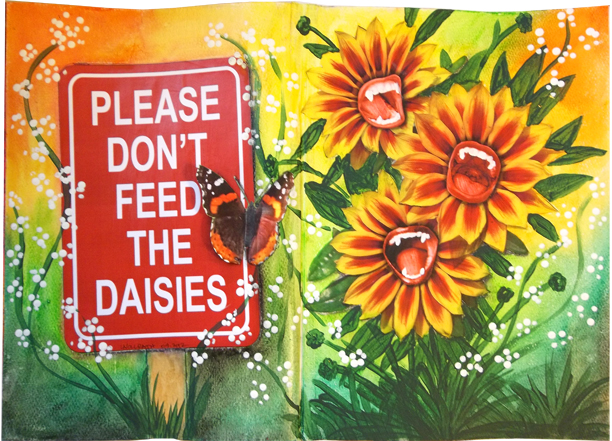
I’ve hosted and participated in hundreds of swaps, round robins, collections, mingles, mail art projects, and calls for art—and I’ve hosted more than my fair share, too. Over the course of all these projects, I’ve learned that not everyone understands what is expected of them when they sign up. Maybe that’s because nobody has ever spelled out how to be a good art swapper. Here’s my attempt to get everyone started on a firmer footing:
1. Know what the hostess has in mind.
When you see a project posted, take a moment to read the instructions. Whether the host is hyper-organized or more laid back, she’s probably laid out what she thinks is important to know about her project. The first thing you can do for her as your swap hostess is take the time to read what she’s written.
2. Know your own schedule and commitments.
Now, read the instructions again, with your calendar or day planner in front of you. Do you really have time in your busy life to consider adding this project to your schedule? Do the dates of the project allow you enough time to work? Are you expecting guests before the due date? Are you throwing a party, getting married, expecting a baby, or starting a new job between now and then? Are you already signed up for two swaps due in the same week as this one? Only you can figure out whether life will allow you to be a good participant in this project. Be a grown-up, and check your schedule.
3. Know how to say no.
On any given day, there are a bazillion really interesting art projects looking for participants. Nobody can do them all. Even if a project sounds really interesting, and you would just love to do it, the best thing you can do sometimes is say no. If you’ve already signed up for other projects, if life is looking particularly hectic, if you have little ones and it’s cold and flu season, or if there’s any doubt at all that you can make this project work in your schedule, it’s time to say no. If the project sounds exciting, but the swap host or the participants are not folks with whom you’ve had good experiences in the past, say no. If you read the swap instructions, and that little voice inside you says this might not be a good idea, just say no! Having the discipline to say no is one of the most valuable traits of a successful art swapper.
4. Know the costs in dollars and time.
Any art project has two basic costs: a financial one, and in time spent. If you’re asked to make one piece of artwork and send it by first class mail a month from now, both costs may seem minimal, and easily absorbed into your schedule and budget. If you’re asked to make 10 original pieces, that takes more time, and 10 times the supplies. If you’re asked to make one piece of artwork, and then send 100 color copies of it, you may have to take out a second mortgage to get it done. Think before you sign up: can you afford the time it will take to make the requested artwork, and do you have the dollars to make it?
Postage costs get many swappers in over their heads. While you’re considering the cost of making the work requested, you should also know how much it’s going to cost to get it where it needs to go by the due date. If you’re asked to mail by a specific method, find out how much it costs to mail something from here to there by that method. All the major carriers have calculators on their sites that will estimate this for you. Use them.
Also watch for return postage costs. If a swap hostess asks you to include a stamped, self-addressed return envelope to her, or to send postage equivalent to what it cost you to mail to her, you’re effectively doubling your mailing costs. Can you afford this? Will you have time to assemble the requested return packaging or fees before you mail? Will you have time to go to the post office, stand in line, and get the paperwork done before the due date? Factor all this into your costs, both in dollars and time. It does you no good to get the artwork done if you can’t afford to mail it out, or can’t get to the post office in time.
5. Know how to operate a calendar.
Seriously—a calendar is not a piece of artwork hanging on the wall, it’s a planning tool . If a project is due by a certain date, that’s not a suggestion. It’s a commitment. Write it on your calendar, and meet your commitment. If you can’t do this, don’t sign up for art projects. Don’t assume that thirty other people will be happy to wait for your items to arrive because you had a hangnail, and couldn’t get to the post office. Don’t leave making things or mailing things until the last possible moment. Look at your calendar, see the deadline date approaching, and do something about it!
6. Know your own skill level and limitations.
This is a tough one. Many people use swaps as a motivator to try something new, which is great if it works for you. However, if you’re timid about trying new things, not sure how to make something without step-by-step instructions, or are hampered by limited supplies or resources, perhaps you shouldn’t swap something you’ve never tried before. So, if you’re signing up to swap soldered microscope slide pendants, and you’ve never soldered, don’t own a soldering iron, have never seen someone solder, don’t have step-by-step instructions on soldering, and are timid about using tools—well, maybe it’s best to try making one before you sign up, rather than sign up for something that you may not be able to deliver.
My approach to this is try making one, and if sign ups for the swap are still open when you’ve achieved a finished piece that doesn’t look half bad, it was meant to be—sign up with confidence. If not, keep practicing so you’re ready for the next time a swap like this one is posted.
7. Know when and how to ask questions.
Everyone has questions at some point in a project. A good swap host will anticipate those questions, and have answers for them. Many hosts write their project descriptions to include those answers, so your first stop when you have questions is the original place you saw it posted. Read through it to be sure your question isn’t covered.
Next, check to see if there’s a project FAQ, or if there’s a project discussion thread. Read through those to see if your question has already been asked and answered. If your question is more general, like how to achieve a certain technique or where to find supplies, try using Google to track down answers.
If all else fails, contact your swap host privately via email. Let her know that you’ve checked the various resources the project offers, and have not found an answer. Be brief, and get to the point—because if there are 30 participants, and each one sends her a three paragraph long email she has to wade through to find a question, she’s probably tired of reading by now.
Be nice. Remember, your swap host is not your servant. Even in small, quiet projects, there’s a lot of juggling going on behind the scenes. Be patient.
8. Know that it’s not all about you.
Signing up for someone else’s project means accepting that things aren’t going to be done your way. By signing up, you’ve agreed to follow the host’s instructions, deadlines, and changes to all of the above within reason. You’ve agreed to become one of a group of participants, with the host as a leader. Every leader has a different style—some will ask for input from the group for every detail of the project, while others will make the decisions on their own. Making demands, or adding your two cents about how a project is run, or forging off on your own and doing whatever you like is not appropriate. This activity is about the group, and what’s best for it as a whole, not what’s best for you.
For example, if a host does not require participants to acknowledge the receipt of swap items after returns are mailed out, it’s not up to you to demand that the people who received your items acknowledge them. Conversely, if the swap rules state that you should post when something from another artist arrives, you should not decide to ignore them. These decisions are not up to you to make. They’ve been made by the host.
Since you read the project description twice, you know what’s expected. If anything in the project description didn’t sit well with you, or wasn’t clear, well, why the heck did you sign up for it?
9. Know that not everyone is like you.
Not everyone makes art the way you do—thank goodness! Our creative lives would be boring if everyone made things the same way. Learn to appreciate the differences in skill levels, materials and techniques.
Not everyone is as responsible as you are. There will be people who drop out, disappear, and receive without giving anything back. All you can do is keep a list of people who have not lived up to your expectations, and avoid participating in projects with them again. As a swap host, I keep a list of people who have not lived up to my expecations as participants. Periodically, I get messages from other swap hosts, and we share information. Some places were I swap regularly have ratings systems that identify participants with poor habits. Eventually, people who have poor swap habits will find themselves left out in the cold.
Not every swap is a good fit for you. If you find a swap host or group is too restrictive, or too laid back for your taste, or if the pace or the energy of a project doesn’t work for you, don’t continue to sign up for swaps in the same place. Finish your commitments, and keep looking. Eventually, you’ll find a few like-minded people, and fall into a happy, healthy situation. Sometimes, it takes a few tries to find a good fit. Don’t get discouraged.
10. Know that it’s not about getting stuff.
If you think that joining an art project is all about people sending you stuff, you’ve missed the boat. Most collaborative projects are best approached as opportunities to make art, stretch your own skills, and do something new. Sign up, meet your responsibilities, send whatever you’re supposed to send, and move on. If things fall apart, and you don’t receive the expected return from a project, it’s not the end of the world.
And if you’re someone who does think it’s all about getting stuff, and you receive without sending—well, I wouldn’t want to be you when that energy comes back around and bites you…
One more thing to know: the people who read this article probably don’t need it—and the people who need it probably won’t read it.




